UIUC Low-Speed Airfoil Tests
The goals of the UIUC Low-Speed Airfoil Tests (UIUC LSATs) program are to design, analyze and wind tunnel test airfoils for low Reynolds number applications. The UIUC Applied Aerodynamics group has been a leader in this research area with new airfoil designs being applied to unmanned aerial vehicles, small wind turbines, model aircraft and many other applications. Over 200 low Reynolds number airfoils, many of them new designs, have been built and validated in the UIUC Subsonic Aerodynamics Lab 3x4 ft wind tunnel with the results being documented in books, reports, theses, and journal/conference publications.

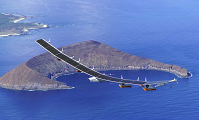
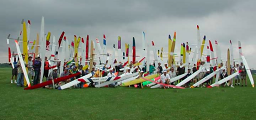
Summary of Low-Speed Airfoil Data Books
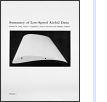 Selig,
M.S., Guglielmo, J.J., Broeren, A.P., and Giguère, P., Summary
of Low-Speed Airfoil Data, Vol. 1, SoarTech Publications, Virginia Beach, VA,
1995, 292 pages. Wind tunnel data on 34 airfoils tested at Reynolds Numbers ranging from
30,000 to 500,000.
Selig,
M.S., Guglielmo, J.J., Broeren, A.P., and Giguère, P., Summary
of Low-Speed Airfoil Data, Vol. 1, SoarTech Publications, Virginia Beach, VA,
1995, 292 pages. Wind tunnel data on 34 airfoils tested at Reynolds Numbers ranging from
30,000 to 500,000.[Download Vol. 1]
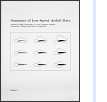 Selig,
M.S., Lyon, C.A., Giguère, P., Ninham, C.P., and Guglielmo,
J.J., Summary of Low-Speed Airfoil Data, Vol. 2, SoarTech
Publications, Virginia Beach, VA, 1996, 252 pages. Wind tunnel data on 25 airfoils
tested at Reynolds Numbers ranging from 40,000 to
400,000.
Selig,
M.S., Lyon, C.A., Giguère, P., Ninham, C.P., and Guglielmo,
J.J., Summary of Low-Speed Airfoil Data, Vol. 2, SoarTech
Publications, Virginia Beach, VA, 1996, 252 pages. Wind tunnel data on 25 airfoils
tested at Reynolds Numbers ranging from 40,000 to
400,000.[Download Vol. 2]
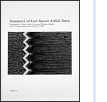 Lyon, C.A.,
Broeren, A.P., Giguère, P., Gopalarathnam, A., and Selig,
M.S., Summary of Low-Speed Airfoil Data, Vol. 3, SoarTech
Publications, Virginia Beach, VA, 1998, 418 pages. Wind tunnel data on 37 airfoils
tested at Reynolds Numbers ranging from 60,000 to
500,000.
Lyon, C.A.,
Broeren, A.P., Giguère, P., Gopalarathnam, A., and Selig,
M.S., Summary of Low-Speed Airfoil Data, Vol. 3, SoarTech
Publications, Virginia Beach, VA, 1998, 418 pages. Wind tunnel data on 37 airfoils
tested at Reynolds Numbers ranging from 60,000 to
500,000.[Download Vol. 3]
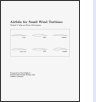 Selig,
M.S. and McGranahan, B.D., Wind Tunnel Aerodynamic Tests of Six
Airfoils for Use on Small Wind
Turbines, National Renewable Energy
Laboratory, NREL/SR-500-34515, Oct 2004, 133 pages. aka
Summary of Low-Speed Airfoil Data - Volume 4. Six airfoils
tested at Reynolds Numbers ranging from 100,000 to 500,000.
Selig,
M.S. and McGranahan, B.D., Wind Tunnel Aerodynamic Tests of Six
Airfoils for Use on Small Wind
Turbines, National Renewable Energy
Laboratory, NREL/SR-500-34515, Oct 2004, 133 pages. aka
Summary of Low-Speed Airfoil Data - Volume 4. Six airfoils
tested at Reynolds Numbers ranging from 100,000 to 500,000.[Download Vol. 4 / NREL Report]
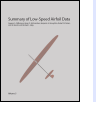 Williamson, G.A.,
McGranahan, B.D, Broughton, B.A., Deters, R.W., Brandt, J.B.,
and Selig, M.S., Summary of Low-Speed Airfoil Data,
Vol 5, 2012, 363 pages. Airfoils: AG12, AG16, AG24, AG35-r,
AG40d-02r with flap, AG455ct-02r with flap, CAL1215j, CAL2263m, CAL4014l, E387, flat
plate airfoil with various leading-edge treatments, MA409, NACA 43012A, S1223 with
Gurney flap, S8064, and S9000 with flap.
Williamson, G.A.,
McGranahan, B.D, Broughton, B.A., Deters, R.W., Brandt, J.B.,
and Selig, M.S., Summary of Low-Speed Airfoil Data,
Vol 5, 2012, 363 pages. Airfoils: AG12, AG16, AG24, AG35-r,
AG40d-02r with flap, AG455ct-02r with flap, CAL1215j, CAL2263m, CAL4014l, E387, flat
plate airfoil with various leading-edge treatments, MA409, NACA 43012A, S1223 with
Gurney flap, S8064, and S9000 with flap.[Download Vol. 5] [Flat plate airfoil tests - additional details by Camille Goudeseune]
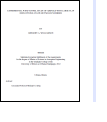 Williamson, G.A. Experimental Wind Tunnel Study
of Airfoils with Large Flap Deflections at Low Reynolds Numbers, Master's
Thesis, Department of Aerospace Engineering, University of Illinois at
Urbana-Champaign, Urbana, IL, 2012, 535 pages. Airfoils: AG40d-02r, AG455ct-02r, W1011, W1015 - all
with very large flap deflections.
Williamson, G.A. Experimental Wind Tunnel Study
of Airfoils with Large Flap Deflections at Low Reynolds Numbers, Master's
Thesis, Department of Aerospace Engineering, University of Illinois at
Urbana-Champaign, Urbana, IL, 2012, 535 pages. Airfoils: AG40d-02r, AG455ct-02r, W1011, W1015 - all
with very large flap deflections.[Download Thesis]
SoarTech 8
The book Airfoils at Low Speeds (SoarTech 8),
includes wind tunnel data on 54 airfoils tested at Reynolds
numbers ranging from 60,000 to 300,000. The book contains extensive
commentary and analysis. Testing was performed at Princeton
University during 1987 and 1988 by Michael Selig, John Donovan and
David Fraser. This work was the important precursor to the low Reynolds
number airfoil research at UIUC. The book and data can be
downloaded for here:
[Download "Airfoils at Low Speeds" (SoarTech #8)]
[Download SoarTech 8 tabulated airfoil data in zip format]
LRN-FB Design
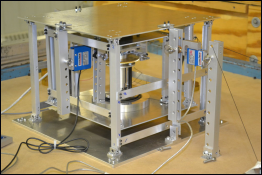 A three-component wind tunnel force
balance was designed and assembled to study the low Reynolds
number aerodynamics of low-to-moderate aspect ratio wings. The
balance designed is capable of measuring lift, drag and moment of
wings. Details of the design, assembly, and calibration of the
three-component force balance can be found in the thesis of Ananda
(2012), here:
http://hdl.handle.net/2142/42319. Solidworks
CAD assembly files together with an IGES file of the whole assembly
are provided below. Please
contact gavin.k.ananda@gmail.com
for more information regarding the force balance design and
calibration techniques. -Gavin Ananda
A three-component wind tunnel force
balance was designed and assembled to study the low Reynolds
number aerodynamics of low-to-moderate aspect ratio wings. The
balance designed is capable of measuring lift, drag and moment of
wings. Details of the design, assembly, and calibration of the
three-component force balance can be found in the thesis of Ananda
(2012), here:
http://hdl.handle.net/2142/42319. Solidworks
CAD assembly files together with an IGES file of the whole assembly
are provided below. Please
contact gavin.k.ananda@gmail.com
for more information regarding the force balance design and
calibration techniques. -Gavin Ananda
[Download "LRN-FB_FinalAssembly.zip"]
[Download "LRN-FB_FullAssembly.IGS"]
Low Reynolds Number Airfoil Data and Documentation
- Composite plots of airfoils tested
- Alphabetical listing of all airfoils tested
- Listing of available datasets in tabular form: [ Vol 1 | Vol 2 | Vol 3 | Vol 4 | Vol 5 ]
- All of the low Reynolds number airfoil data in
Vols 1-4 and SoarTech 8 data are available here online in plain ASCII text files. The
first two volumes include lift and drag coefficient data while
 the second two volumes also include pitching
moment data. For SoarTech 8 tabulated airfoil data, see link above.
the second two volumes also include pitching
moment data. For SoarTech 8 tabulated airfoil data, see link above. 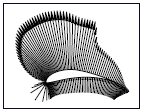 S9104
heavy lift/high lift airfoil: Designed in yr 2023, this single-element airfoil
is predicted to achieve a lift coefficient of
nearly 2.6 at a Reynolds number of 200,000.
The airfoil has approximately 10% more lift than the S1223.
The link above includes the coordinates (plus airfoil as a nurb
curve) and performance predictions from XFOIL.
S9104
heavy lift/high lift airfoil: Designed in yr 2023, this single-element airfoil
is predicted to achieve a lift coefficient of
nearly 2.6 at a Reynolds number of 200,000.
The airfoil has approximately 10% more lift than the S1223.
The link above includes the coordinates (plus airfoil as a nurb
curve) and performance predictions from XFOIL.- S1223
lift and pitching moment plots: The S1223 is a popular airfoil
 used in the SAE Aero Design Competition. The airfoil first
appeared in UIUC LSATs Vol 1 without pitching moment data, but
these data were taken after Vol 1 and posted here online.
Additional data on the S1223 with Gurney flaps is in Vol 5.
used in the SAE Aero Design Competition. The airfoil first
appeared in UIUC LSATs Vol 1 without pitching moment data, but
these data were taken after Vol 1 and posted here online.
Additional data on the S1223 with Gurney flaps is in Vol 5.
 SG6050 and SG6051:
These airfoils were designed and tested for the WindLite 8 kW wind
turbine. They are semisymmetrical with an aft flat bottom for
easy building. The experimental data was publically released in 2016 thanks to
the agreement of the project
sponsor.
SG6050 and SG6051:
These airfoils were designed and tested for the WindLite 8 kW wind
turbine. They are semisymmetrical with an aft flat bottom for
easy building. The experimental data was publically released in 2016 thanks to
the agreement of the project
sponsor. Low Reynolds number airfoils are
defined by having a laminar separation bubble that causes an
increase in drag. This bubble can be seen by injecting smoke into
the boundary layer and also by a technique called oil flow
visualization [graphics downloads].
Low Reynolds number airfoils are
defined by having a laminar separation bubble that causes an
increase in drag. This bubble can be seen by injecting smoke into
the boundary layer and also by a technique called oil flow
visualization [graphics downloads].- "Theory, testing and in-flight: put teeth on it and take a bite out of your airplane's stall" by Camille Goudeseune -- is a nice article about the effects of applying leading edge serrations on a flat plate airfoil. These data are also included in the Summary of Low-Speed Airfoil Data, Vol 5 above.
Low Reynolds Number Airfoil Publications
Some additional low Reynolds number airfoil publications from our group are listed below.
- Selig, M.S., Deters, R.W., and Williamson, G.A., "Wind Tunnel Testing Airfoils at Low Reynolds Numbers," 49th AIAA Aerospace Sciences Meeting, AIAA Paper 2011-875, Orlando, FL, January 2011. | PDF
- Selig, M.S. and McGranahan, B.D., "Wind Tunnel Aerodynamic Tests of Six Airfoils for Use on Small Wind Turbines," ASME Journal of Solar Energy Engineering, Vol. 126, November 2004, pp. 986-1001. | PDF
- Selig, M.S. and McGranahan, B.D., "Wind Tunnel Aerodynamic Tests of Six Airfoils for Use on Small Wind Turbines," AIAA Paper 2004-1188. | PDF
- Selig, M.S., "Low Reynolds Number Airfoil Design," VKI Lecture Series - Low Reynolds Number Aerodynamics on Aircraft Including Applications in Emerging UAV Technology, von Karman Institute for Fluid Dynamics (VKI) Lecture Series, RTO/AVT-VKI-104, November 2003. | PDF
- McGranahan, B.D. and Selig, M.S., "Surface Oil Flow Measurements on Several Airfoils at Low Reynolds Numbers," AIAA 42nd Applied Aerodynamics Conference, AIAA Paper 2003-4067, Orlando, FL, June 2003. | PDF
- Gopalarathnam, A., Broughton, B.A., McGranahan, B.D., and Selig, M.S., "Design of Low Reynolds Number Airfoils with Trips," Journal of Aircraft, Vol. 40, No. 4, 2003, pp. 768-775. | PDF
- Giguère, P. and Selig, M.S., "New Airfoils for Small Horizontal Axis Wind Turbines," ASME Journal of Solar Energy Engineering, Vol. 120, May 1998, pp. 108-114. | PDF
- Selig, M.S. and Guglielmo, J.J., "High-Lift Low Reynolds Number Airfoil Design," Journal of Aircraft, Vol. 34, No. 1, January-February 1997, pp. 72-79. | PDF



